Mutual credit in Africa: interview with Will Ruddick of Grassroots Economics
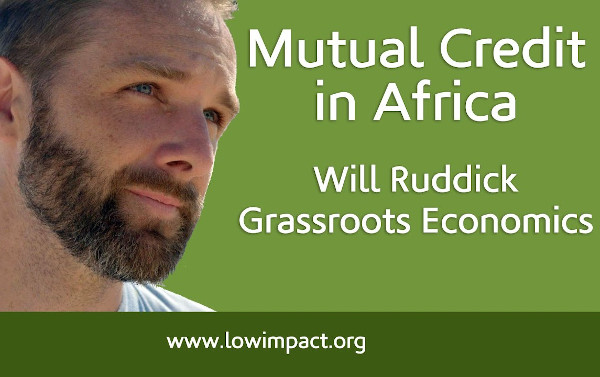
I’d like to introduce Will Ruddick, who set up the Grassroots Economics Foundation in Kenya around ten years ago, that runs a very successful mutual credit network (called the Sarafu Network) there.
Hello Will. Really nice to talk with you.
Hi Dave.
I think you have something like 40,000 trading members, with $2.5 million worth of trade last year. Is that right?
Yeah. I think we’re up to 48,000 households registered. And regular usage – about 2000 active traders per week. And some trade seasonally.
And some schemes in South Africa too? Is that right?
We tried, but they didn’t really take off.
And in Kenya – about $2.5 million worth of trade last year?
Yes. The tokens are generally used as a top-up to Kenyan shillings.
But with no conventional money involved in your networks at all?
Not unless people trade with it, in the same way that they would trade with tomatoes. There are cases where someone is going to buy tomatoes and she doesn’t have money, so she uses tokens – but she might come back later and buy those tokens back with cash. So in some senses, Sarafu will be considered an iou, which can be paid in cash or goods / services. We’ll also sometimes get donors coming in to work with a ‘Chama’ – and buy up some of their Sarafu.
So the first big thing I want to ask you is why? What’s the problem you’re trying to solve – what’s your motivation?
Informal debts, lack of credit, lack of currency is such a rampant, visceral thing in Kenya. I’m from the US originally, and I came here with the Peace Corps about 12 years ago, and I’d read Bernard Lietaer’s books, and visited Berkshares and other places. I was really excited by the concept, and thought that in the development sector there was a lot more need for it. I learnt Swahili and started working with community groups, showing videos of what was happening in places like Banco Palmas (Brazil) and Berkshares (US) and other systems, and co-designing with the community what they thought might work. We tried different designs (well over 20 variations of community currency design), and we’re not done with experimenting.
Why community currencies? What was the problem with conventional money?
It just wasn’t there. There are a lot of other problems with conventional money, in terms of how it’s issued and distributed across the world; how it’s extractive; debt is constantly growing. But fundamentally, here in Kenya, it’s not available. There are a lot of organisations popping up trying to provide credit to very poor people, at rates of 7% per day. Some people are taking out loans to eat.
Yes, when we talk about poverty in the West – it’s a different scale in Kenya isn’t it?
Yes. But out here, there’s more opportunity for people to live off the land or create community structures. A lot of Kenyans are already community-based and grow a lot of their own food. They don’t go to big supermarkets etc. Creating systems among each other, creating commons, is a lot more possible here than in the North (although it’s not impossible in the North). So there’s an advantage for community currencies in that way.
How many communities are you working with in Kenya now?
We don’t even know any more. We’re giving about 100-200 registrations every day, from all over the country. There are 3 groups in Kakuma refugee camp. So we started with paper currencies. We don’t do them any more – they were expensive to print, we were taking them around in suitcases. It was not ideal. We also went to jail for doing some of this stuff too.
OK, right, I want to hear more about that – how did that happen?
There was a sensational newspaper article, saying that we were part of Al-Shabab, and we were secessionists. That article got picked up by the central bank – they sent in riot squads to kick doors down and put us in jail. We had to wait several days for them to figure out what the charges were going to be. Eventually they settled on forgery, although our notes didn’t look like Kenyan shillings. But no laws were being broken, so we ended up doing an international petition, and eventually the public prosecutor said that there was no Kenyan law that we were breaking. So we were able to get out of jail, and then lots of communities wanted these programmes, and so we started coming up with different designs for different communities.
They’re very beautiful.
I actually miss them a lot. But I don’t miss having to deal with them.
I heard that after the court case, the chief of police came to your relaunch event – is that right?
One of the local ones, yes. Plus the local member of parliament, and local chiefs / elders. In fact, when we go into communities, the first thing is for local people to bring together the elders. We hadn’t done the proper ‘asking for permission’ from the central bank – but had we done so, we might never have started. We’ve done a lot of legal due diligence since then. It’s up to the state to impose regulatory environments on us. It’s no up to us to wait for that to happen first.
It’s better to ask for forgiveness than for permission.
Exactly. We’re a non-profit. There’s no cash involved. We keep good accounts etc. We’re not doing anything wrong.
So what do you do exactly? How does it work?
It’s a bit confusing, because at the end of 2019, we had 11 currencies, we’d gone digital, and trading was happening through ‘liquidity pools’ where a village could trade with another village, and we were experimenting with blockchain. Then in 2020, we’d been using third-party APIs to connect to the blockchain. We wanted to be totally open source, so we had to go back down to there being just one token. So we created the Sarafu token, and replaced all the digital currencies in Kenya with just this one token. It became like a UBI-esque programme – so anyone in the country dials a little code, and they get 100 credits.
Just using a non-smart phone?
Yes. You don’t need the internet. Which is why it works in refugee camps. So that enabled anyone in the country to start using it. They can get this little credit line. We put a demurrage on that too – a negative interest – which gets redistributed back out to active users.
To explain – this demurrage means that it becomes more expensive to hold on to the tokens, so it encourages people to spend them.
Yes. I our case it’s more like a holding tax. It’s 2% per month, and in the system we’re about to implement, it will be 0.000015% per minute, so you don’t get the ‘hot potato’ situation of people trying to get rid of their balance before the end of the month. The demurrage is redistributed back to active users, so it doesn’t reduce the money supply.
Does that work – does it get people trading? You don’t employ any brokers do you?
We operate a phone centre, and we work with the Red Cross to do this as well. We try to organise people into Chamas (community groups), and the Chamas will organise this kind of brokering stuff themselves. If people have no tokens, they need to do community work or to sell products or services to increase their balance. A big focus is on building social work / public food / training in permaculture and agroforestry etc. Chamas pool their Sarafu to pay for public works. People can then use their Sarafu to buy from those public works. So it’s a nice closed-loop system. Chamas are everywhere in Kenya, so we work with them. They’re a great way to guarantee circulation. The holding tax does deter people from having very high balances. The future of these programmes is hopefully in communities creating their own currencies. Sarafu is a useful tool, but the goal is for communities to have their own tokens, with their own rules. We want a decentralised system. We fell into this nationwide UBI-like system. This doesn’t have to end, but ideally it will give birth to a lot more local mechanisms. And they can all connect with each other.
Can I ask a few basic questions. For example you mentioned liquidity pools – could you just explain what that means?
Imagine a money-changer standing at the side of the road. He’s got euros, Kenyans shillings – those are his assets. A liquidity pool has assets from both sides – let’s say they’re both currencies. That person will take dollars or euros and spit out Kenyan shillings. In the blockchain realm, these have been liquidity pools that do the same job as the money-changer.
So if you have two currencies in the liquidity pool, someone using one currency can put that currency in, and a different currency will be pushed out to someone using that different currency?
Exactly. And there are rules – for example flat exchange rate, or it could be a diminishing returns equation – so the more you push in the less you get out the other side (to balance trade), and so on. These are sometimes called bonding curves. They can connect together different communities in a really decentralised way.
Can anybody, in any group anywhere in Kenya, trade with anybody else?
There’s only one token at the moment, so yes. In future, let’s say Darby village has a Darby coin, and you’ve created a million of these tokens, that are being used in your community. Let’s say you want to set up a liquidity pool – you’d take, say, 10,000 of your Darbys and put them together with 10,000 of some other currency, and you could exchange between the two currencies. The exchange is voluntary and completely separate from the currency issuance.
So when people join the scheme, they get 100 tokens to get them started. Could you just explain where those 100 tokens come from?
They’re ‘minted’ – it’s a credit, that’s just being created, not backed by anything. This is equivalent to giving someone a 100 unit credit line – so that they can go 100 into the negative. It’s almost too simple. It disturbs people a bit – we’re just creating a credit space, and using it as liquidity, to get people spending.
So it’s exactly the same as a mutual credit scheme, when people join and get a balance of zero, and they can sell, and go into the positive, or buy, and go into the negative. It’s the same, but it’s moved so that people start with 100 credits, and can’t go into the negative? I guess people might find that easier to understand? You’ve got something you can spend, and you always stay in the positive, as you do when you have cash.
I think mutual credit, with positive and negative balances, is totally valid. We want to trial a lot more of that. I suspect it might be confusing for people though, especially with negative numbers – that are often frowned upon.
People feel that they’re in debt?
But in any system, you’re going to get imbalances; so any system that incentivises people internally to know their trade balance with other people is really important. The demurrage is another important thing – when people realise that having a large balance isn’t going to help them. And also Chamas, these women’s groups, coming together, helping to clear credit between groups. New businesses get created too. Creating social services in this way – new businesses spring up that take this ‘community-created basic income’ (in effect). I think that’s really beautiful. All of those are like a toolkit of techniques to take any kind of credit system and make it flow.
If there were some sort of global federation / credit commons, then a mutual credit network in the UK, where they can go into the negative – they can intertrade with your groups in Kenya – there’s no barrier to that?
Exactly. There’s no way to stop that from happening. Any similar scheme can intertrade. The technology is there. It’s like trying to stop the guy exchanging money in the street. It’s always going to happen. Especially with token issuance – there can be rules and networks for connecting tokens together. There can be federated value, and commons of those systems.
I interviewed Mercedes from Quipu Markets in Colombia. I think she visited you to see how you do things. She’s trying to spread the idea around Latin America. Do you think these ideas will spread more rapidly in Africa, Asia and Latin America?
Yes. Like Banco Palmas (Brazil). Brazil is amazing. I think the humanitarian space is a natural ally. Humanitarians have started distributing cash in poor parts of the world. But what kind of cash? Why not empower people to make their own? That does make sense to people in the World Food Programme, the Red Cross etc. So things are starting to move. It’s super-exciting.
Yes. Conventional cash always leaches out eventually.
Yes, and it breeds dependency. There are places where the humanitarian sector has been doing cash injections, and if they stop, hundreds of thousands of people could die. You end up in dependency relationships, which is the opposite of what humanitarian organisations are supposed to do. They’re supposed to be empowering. The concept of cash being better than building things and doing things locally. Maybe that’s more transparent, but it hasn’t been sustainable. And there are lots of studies that show that cash injections work, because injecting liquidity is powerful. It’s just that if that liquidity is dependent on some foreign state, or even national governments, it’s really fragile. I’m a proponent of basic income type programmes – and that’s what the humanitarian sector is doing. I just want those basic incomes to come from communities.
Yes. You started to tell me about a German development agency, GIZ, pumping several million dollars into Cameroon to start community currencies there.
There are pilots starting all over the place. That’s one of the big ones. The German government has been excited by community currencies, and GIZ is their development agency. They’re looking at implementing in Cameroon – even to the point of creating tax systems in community currency – which is a big thing. In Kenya, 70% of the population pay no taxes whatsoever, so if governments can see this as a tax source, and it becomes transparent as to where that tax is going – so I like the blockchain aspect for this reason. It could be amazingly powerful.
What’s your plan / ambition / ideal scenario?
If the entire world gets a decentralised financial system with inter-connected mutual credits, I think that could be amazingly beautiful, and move us past this ‘Stage 1 Civilisation’ where we actually start to look at what we want to do as humans, rather than just make money.
That’s a really good vision.
There’s so much to do here. For example regenerative agriculture. I look at these massive landscape restoration projects going on in the world. Many of them stopped because there’s not enough money. Here are ways we can support the environment, regenerate the soil etc, but we don’t have the money. With the sustainable development goals, there’s a 3 trillion dollars gap in funding them. The World Bank says there’s a 3 trillion gap in credit supply. We can solve all those problems at the same time, by letting people create their own credit. Then they can fund their own regenerative agriculture. When I go out to a village, and there’s training (usually one village training the next) in agriculture – a lot of it very labour-intensive – lots of mulching, dealing with water etc. To pay for all that labour would be impossible with cash. Even if we had funding, it’s not going to happen. So to say that we can create our own credit based on the future production of the farms. To me, regenerative agriculture is the real project of our time. We can make deserts bloom, and we can repair all the land we’ve destroyed in the last few hundred years. Most land in Kenya was fertile soil 200 years ago. Forests were cut down, and after a few generations of slash and burn, it’s got worse and worse. Mobilising people to do the work that needs to be done – that’s exciting, and it’s where the humanitarian sector and governments can come in.
I love your vision. There are large vested interests, and your vision isn’t really in their interest. Do you think they’re going to sit by and let this happen, or try to block it?
I don’t know. I think there are all sorts of possibilities. We have a lot of potential allies too – there are a lot of ethical banks, like Triodos and others, who want to see this stuff happen. It’s a matter of finding good partnerships. There’s a lot of funding for these types of projects. I think we just need to push harder.
What could people do to help?
Reach out in your community and start a programme. Working with their municipalities, with community groups, churches, neighbours, and coming up with reciprocal trade arrangements. There are lots of ways to do this. There are timebanks, mutual credit programmes, lots of stuff. This is much easier in countries with reliable internet access for most people. A lot of it’s not about tech. It’s about finding the people, the structure. Getting businesses and projects / public services to accept these currencies is a huge thing. It’s about creating commons. Community currencies are one way of paying for the maintenance – for the flows in and out of that. Bringing social enterprises and co-ops into these kinds of economic flows is so powerful. CSA, community energy etc. need to be knitted together in a strong network, and community-owned currencies are a way to do that.
Yes, it’s the thing that knits it all together.
Exactly. With extractive flows, it’s not sustainable. It’s hard to build things in an extractive system, so if you can create a space among your neighbours, your municipality, co-ops, social enterprises, other organisations etc. that can get us away from waiting for the national government to do things for us. We can create our own abundance.
Where can people keep up to speed with what you’re doing?
I blog at grassecon.org. I’m @WOR on Twitter. This is all action research. I try to expose everything we’re doing as much as I can. Whatever we learn we share. Sharing information is really important. We’re building a toolkit to build the next economy and the next civilisation. We need to make sure it’s all free and open sourced.
What you’re doing is really exciting – especially as it’s so successful. It’s been great talking with you. Hopefully I can interview you again when you’re much bigger.
I’m happy to be small though. Let everyone do this kind of work.
There’s a book on the way about building a new economy around a mutual credit core.
Highlights
- 48,000 users registered; $3 million worth of trade last year.
- Humanitarians have started distributing cash in poor parts of the world. But what kind of cash? Why not empower people to make their own? That does make sense to people in the World Food Programme, the Red Cross etc. So things are starting to move. It’s super-exciting.
- If the entire world gets a decentralised financial system with inter-connected mutual credits, I think that could be amazingly beautiful, and move us past this ‘Stage 1 Civilisation’ where we actually start to look at what we want to do as humans, rather than just make money.
- It’s hard to build things in an extractive system, so if you can create a space among your neighbours, your municipality, co-ops, social enterprises, other organisations etc. that can get us away from waiting for the national government to do things for us. We can create our own abundance.
The views expressed in our blog are those of the author and not necessarily lowimpact.org's
1 Comment
-
1Dave Darby April 18th, 2021
I don’t think this was made clear enough in the interview, but his network is mutual credit, but instead of having an account set at zero and having a negative limit of (say) 100, members of his network get 100 units when they join, but can’t go below zero. But if you think about it, that’s exactly the same. Brett Scott talks about seeing the negative ‘shadow’ of money – https://brettscott.substack.com/p/seeing-money-shadows




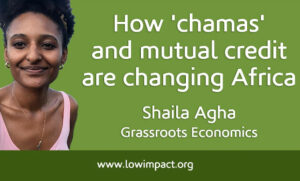 How ‘chamas’ and mutual credit are changing Africa: Shaila Agha of the Sarafu Network
How ‘chamas’ and mutual credit are changing Africa: Shaila Agha of the Sarafu Network
 Mutual credit in Colombia: Mercedes Bidart of Quipu Markets
Mutual credit in Colombia: Mercedes Bidart of Quipu Markets
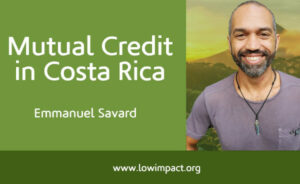 Building the new economy with mutual credit in Costa Rica
Building the new economy with mutual credit in Costa Rica
 Regenerative traditions in Africa: inspiration for the commons everywhere
Regenerative traditions in Africa: inspiration for the commons everywhere
 Commoning
Commoning
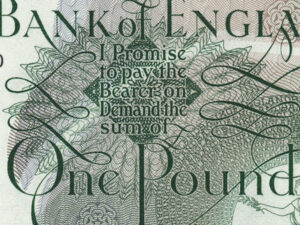 Low-impact money
Low-impact money
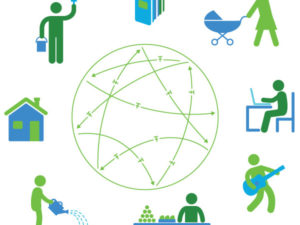 Mutual credit
Mutual credit
 Commons economy
Commons economy


